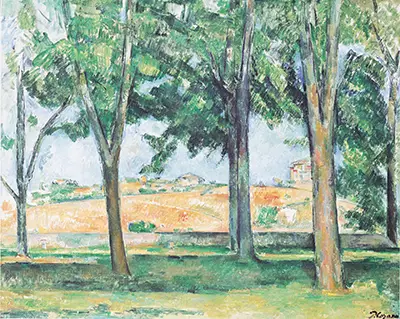Les Marronniers du Jas de Bouffan, or Horse-chestnut trees at Jas de Bouffan, is dated at around 1885. The location for this piece was the mansion owned by Paul Cezanne's father. His son would regularly work within the surrounding gardens in search of inspiration.
One of the features that most interested Paul Cezanne was a row of trees which lined a footpath. A small farmhouse was close by, and it is believed that he actually set up studio within the building. Cezanne would also move his easel all around the property, working both indoors and outdoors. The row of trees seemed of little important visually but the artist appreciated the structure that it could bring to his paintings, and he also observed its changing aesthetic across the years as seasons came and went. The trees would normally produce a strip of shadow down the middle, with light tones found elsewhere and this contrast was another opportunity for his paintings. In total, he would release 30-40 different artworks of scenes of the mansion and its surrounding areas. The property itself would remain in the ownership of the family for around 40 years in total and can be visited today for those looking to understand more about this body of Cezanne's work.
Within this subtlely toned piece we find the trees fairly close to us in the foreground. Their tops are cropped out and the trunks reach almost to the bottom of the painting. A low wall stretches all across the horizontal. Behind in the distance we can see a small village with bright sky behind. In this example the spring or summer weather has allowed the trees to flourish, with an abundance of green leaves covering each of them. Cezanne is loose with his brushwork, filling leaves in with relatively long strokes of green paint which have not been fused together. A large swathe of orange adds to the feeling of warmth and brightness within this piece, with just a few footpaths leading up to the buildings in the distance. Small touches of bright green are added to bring foliage into the village itself and continue this theme of rural life.
The painting is believed to have been acquired by the Volkart Foundation which is based in Switzerland, though is less well known that some of the artist's other contributions to this series. For example, The Driveway at the Jas de Bouffan features similar content from an alternative angle and has been researched and discussed in far greater detail, possibly because of its inclusion within a public gallery. It is often the most accessible items that receive the most interest from researchers and with so many excellent works to be found in this series, all of which are fairly similar, it is unsurprising that paintings which are more readily available are given more attention.




